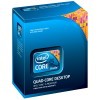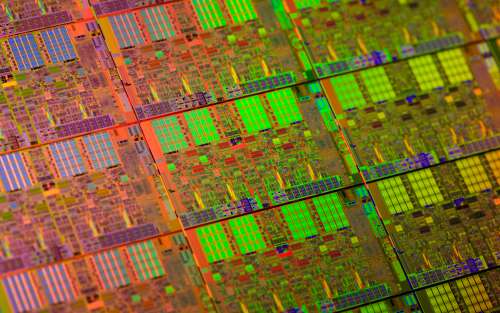- Qualcomm Launches Snapdragon 4 Gen 2 Mobile Platform
- AMD Launches Ryzen PRO 7000 Series Mobile & Desktop Platform
- Intel Launches Sleek Single-Slot Arc Pro A60 Workstation Graphics Card
- NVIDIA Announces Latest Ada Lovelace Additions: GeForce RTX 4060 Ti & RTX 4060
- Maxon Redshift With AMD Radeon GPU Rendering Support Now Available
Intel Core i7-870 & i5-750 – Nehalem for the Mainstream

The wait for Intel’s Lynnfield has been long, but it’s safe to say that it’s been well worth it. They may be considered “mainstream” models, but the new Core i5 and i7 processors are powerful. Expect faster performance, improved power consumption and greater efficiency. With the i5-750 set to sell for $199, the time to build that new PC is now.
Page 12 – Power Consumption, Final Thoughts
It goes without saying that power efficiency is at the forefront of many consumers’ minds today, and for good reason. Whether you are trying to save money or the environment – or both – it’s good to know just how much effort certain vendors are putting into their products to help them excel in this area. Both AMD and Intel have worked hard to develop efficient chips, and that’s evident with each new launch. The CPUs are getting faster, and use less power, and hopefully things will stay that way.
To help see what kind of wattage a given processor draws on average, we use a Kill-A-Watt that’s plugged into a power bar that’s in turn plugged into one of the wall sockets, with the test system plugged directly into that. The monitor and other components are plugged into the other socket and is not connected to the Kill-A-Watt. For our system specifications, please refer to our methodology page.
To test, the computer is first boot up and left to sit at idle for five minutes, at which point the current wattage is recorded if stable. To test for full CPU load, IntelBurnTest is run with maximum memory stress for a total of five minutes. During that run, the highest point the wattage reaches on the meter is captured and becomes our “Max Load”. For i7, we use eight instances of SP2004 instead of IntelBurnTest, as the latter is not yet fully compatible with the newer processors.

The results above are nothing short of staggering. The Core i5-750 used less power at idle than the lowly Dual-Core E7200, and it hardly pulled out ahead at full load. Where the Core i7-870 is concerned, it used far less power than the i7-965, yet proved itself to only be ~10% – 15% slower than the faster i7-975 throughout all of our tests.
Lynnfield is more efficient than Core 2 overall, but the drop seen here no doubt has a lot to do with the removal of the Northbridge. With us down to two chipsets, less power is required, and coupled with already power-efficient processors, the results are amazing. Just wait until we see the mobile version (Clarksfield)…
Final Thoughts
When Nehalem launched, we received processors that were more powerful than anything we used before, and the brand-new architecture was a lot of fun to experiment with. But as I said before, there were a few reasons why people either chose to go with Core 2 or didn’t upgrade their machines at all. Hopefully, Lynnfield will get people to build the rigs they’ve been holding out for.
Let’s kick things off with the Core i5-750. This chip has a caveat… a lack of HyperThreading. Depending on what you do on your PC, that omission may or may not mean much. For me personally, I’ve become a huge fan of HyperThreading ever since the Nehalem launch, because there are many scenarios when it will come in handy.
For workstation-type applications, HyperThreading isn’t so much a luxury, but a requirement. The gains in performance in such applications as 3ds Max can’t be ignored. If you don’t have HT, your renders are taking a lot longer to complete. Fortunately though, for those who don’t use workstation apps often or at all, don’t have too much to be concerned over.
Thanks to the Turbo alone, the i5-750 kept near the top of most of our charts, only to be surpassed either by a CPU with a greater raw frequency or by one that had HyperThreading. In our Adobe Lightroom and TMPGEnc Xpress tests, Turbo did enough to keep this lowly $200 CPU ahead of everything else we’ve tested, aside from the faster Nehalem’s of course
 Up-Close Photo of a Lynnfield Wafer
Up-Close Photo of a Lynnfield Wafer |
To understand just how great the Core i5-750 is, you need to compare it to the previous Core 2 Quad line-up. The Q9650, for example, used to be a $1,000 chip, but it now sits at $316 according to Intel’s recent pricing list. At $316, it’s ~$116 more expensive, yet it managed to surpass the performance of the i5-750 in only three of our tests, and even then, the results were close.
Couple that with the fact that the new chip overclocks well, the $199 price tag is going to be heartily welcomed by those who want to build a fast new PC and not empty their wallet.
So, how about the new Core i7’s? Like the Core i5-750, the Core i7-870 is simply an incredible offering. Thanks to its HyperThreading capabilities and improved Turbo, it scored right under the Core i7-975 Extreme Edition in most of our tests, and if it didn’t, it was never that far off. This, for a CPU that costs 45% less. That’s impressive.
With this kind of performance being exhibited, the Core i7-950 isn’t so much a viable option right now, unless prices are dropped, because both retail for around the same price, and I’m confident that the i7-870, thanks to its Turbo mode, would beat out the i7-950 in most tests. In this case, it all boils down to what’s more important, the features of X58, or slightly improved performance. For dual-GPU configurations, the i7-920 – i7-975 are still the best options, thanks to the dual PCIe 16x capability.
To be honest, I feel that the best processor of the three launched today is the one we didn’t test, the Core i7-860. We can make this assumption because it’s not much slower than the i7-870 (2.93GHz -> 2.80GHz), and still retains HyperThreading. Yet despite the slight drop in its overall frequency, it retails for only $285. After seeing what the Core i7-870 can do, seeing something just a bit slower for $285 is exciting. If I had the need to upgrade or build a new machine right now, the Core i7-860 is the model I’d run to.
I think it’s safe to say that with its Lynnfield processors, Intel has successfully redefined processor value, regardless of which model you’re looking at.
What about our overclocking results? Don’t fret… they’re en route. Due to some complications prior to publishing (thanks to the CPU cooler), and the looming embargo time, we didn’t manage to get the overclocking pages in we hoped to. Stay tuned though, as we’ll soon be unveiling all of our overclocking information in a special two-page article. You won’t want to miss it, trust me!
Discuss this article in our forums!
Have a comment you wish to make on this article? Recommendations? Criticism? Feel free to head over to our related thread and put your words to our virtual paper! There is no requirement to register in order to respond to these threads, but it sure doesn’t hurt!
Support our efforts! With ad revenue at an all-time low for written websites, we're relying more than ever on reader support to help us continue putting so much effort into this type of content. You can support us by becoming a Patron, or by using our Amazon shopping affiliate links listed through our articles. Thanks for your support!





